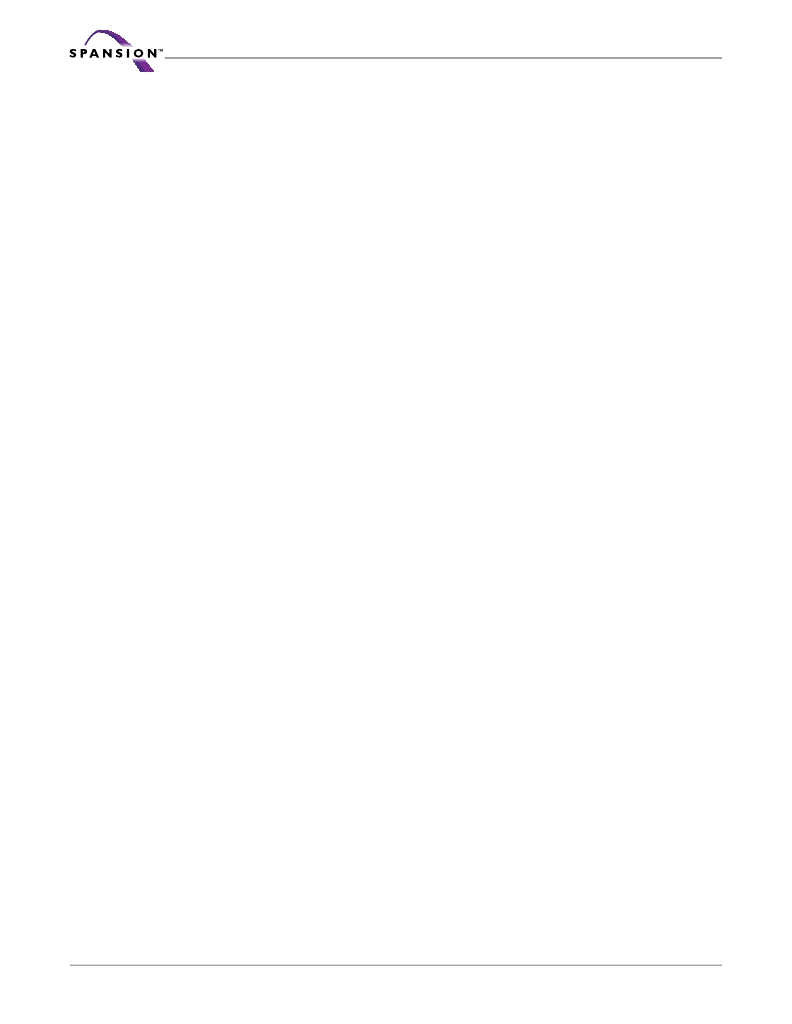- 您現(xiàn)在的位置:買賣IC網(wǎng) > PDF目錄374649 > S29AL004D90BAI023 (SPANSION LLC) 4 Megabit (512 Kx 8-Bit/256 K x 16-Bit) CMOS 3.0 Volt-only Boot Sector Flash Memory PDF資料下載
參數(shù)資料
| 型號: | S29AL004D90BAI023 |
| 廠商: | SPANSION LLC |
| 元件分類: | DRAM |
| 英文描述: | 4 Megabit (512 Kx 8-Bit/256 K x 16-Bit) CMOS 3.0 Volt-only Boot Sector Flash Memory |
| 中文描述: | 256K X 16 FLASH 3V PROM, 90 ns, PBGA48 |
| 封裝: | 8.15 X 6.15 MM, FBGA-48 |
| 文件頁數(shù): | 30/55頁 |
| 文件大小: | 1481K |
| 代理商: | S29AL004D90BAI023 |
第1頁第2頁第3頁第4頁第5頁第6頁第7頁第8頁第9頁第10頁第11頁第12頁第13頁第14頁第15頁第16頁第17頁第18頁第19頁第20頁第21頁第22頁第23頁第24頁第25頁第26頁第27頁第28頁第29頁當前第30頁第31頁第32頁第33頁第34頁第35頁第36頁第37頁第38頁第39頁第40頁第41頁第42頁第43頁第44頁第45頁第46頁第47頁第48頁第49頁第50頁第51頁第52頁第53頁第54頁第55頁

28
S29AL004D
S29AL004D_00_A1 February 18, 2005
A d v a n c e I n f o r m a t i o n
If the output is low (Busy), the device is actively erasing or programming. (This
includes programming in the Erase Suspend mode.) If the output is high (Ready),
the device is ready to read array data (including during the Erase Suspend
mode), or is in the standby mode.
Table 6 on page 31
shows the outputs for RY/BY#.
Figure 13, on page 37
,
Figure
14, on page 38
,
Figure 17, on page 42
, and
Figure 18, on page 43
shows RY/BY#
for read, reset, program, and erase operations, respectively.
DQ6: Toggle Bit I
Toggle Bit I on DQ6 indicates whether an Embedded Program or Erase algorithm
is in progress or complete, or whether the device has entered the Erase Suspend
mode. Toggle Bit I may be read at any address, and is valid after the rising edge
of the final WE# pulse in the command sequence (prior to the program or erase
operation), and during the sector erase time-out.
During an Embedded Program or Erase algorithm operation, successive read cy-
cles to any address cause DQ6 to toggle. (The system may use either OE# or CE#
to control the read cycles.) When the operation is complete, DQ6 stops toggling.
After an erase command sequence is written, if all sectors selected for erasing
are protected, DQ6 toggles for approximately 100 μs, then returns to reading
array data. If not all selected sectors are protected, the Embedded Erase algo-
rithm erases the unprotected sectors, and ignores the selected sectors that are
protected.
The system can use DQ6 and DQ2 together to determine whether a sector is ac-
tively erasing or is erase-suspended. When the device is actively erasing (that is,
the Embedded Erase algorithm is in progress), DQ6 toggles. When the device en-
ters the Erase Suspend mode, DQ6 stops toggling. However, the system must
also use DQ2 to determine which sectors are erasing or erase-suspended. Alter-
natively, the system can use DQ7 (see the subsection on
DQ7: Data# Polling on
page 26
).
If a program address falls within a protected sector, DQ6 toggles for approxi-
mately 1 μs after the program command sequence is written, then returns to
reading array data.
DQ6 also toggles during the erase-suspend-program mode, and stops toggling
once the Embedded Program algorithm is complete.
Table 6 on page 31
shows the outputs for Toggle Bit I on DQ6.
Figure 6, on page
30
shows the toggle bit algorithm.
Figure 20, on page 44
shows the toggle bit
timing diagrams.
Figure 21, on page 45
shows the differences between DQ2 and
DQ6 in graphical form. See also the subsection on
DQ2: Toggle Bit II on
page 28
.
DQ2: Toggle Bit II
The
Toggle Bit II
on DQ2, when used with DQ6, indicates whether a particular
sector is actively erasing (that is, the Embedded Erase algorithm is in progress),
or whether that sector is erase-suspended. Toggle Bit II is valid after the rising
edge of the final WE# pulse in the command sequence.
DQ2 toggles when the system reads at addresses within those sectors that are
selected for erasure. (The system may use either OE# or CE# to control the read
cycles.) But DQ2 cannot distinguish whether the sector is actively erasing or is
erase-suspended. DQ6, by comparison, indicates whether the device is actively
erasing, or is in Erase Suspend, but cannot distinguish which sectors are selected
相關PDF資料 |
PDF描述 |
|---|---|
| S29AL004D90BFI010 | 4 Megabit (512 Kx 8-Bit/256 K x 16-Bit) CMOS 3.0 Volt-only Boot Sector Flash Memory |
| S29AL004D90BFI012 | 4 Megabit (512 Kx 8-Bit/256 K x 16-Bit) CMOS 3.0 Volt-only Boot Sector Flash Memory |
| S29AL004D90BFI013 | 4 Megabit (512 Kx 8-Bit/256 K x 16-Bit) CMOS 3.0 Volt-only Boot Sector Flash Memory |
| S29AL004D90BFI020 | 4 Megabit (512 Kx 8-Bit/256 K x 16-Bit) CMOS 3.0 Volt-only Boot Sector Flash Memory |
| S29AL004D90BFI022 | 4 Megabit (512 Kx 8-Bit/256 K x 16-Bit) CMOS 3.0 Volt-only Boot Sector Flash Memory |
相關代理商/技術參數(shù) |
參數(shù)描述 |
|---|---|
| S29AL004D90BFI010 | 制造商:SPANSION 制造商全稱:SPANSION 功能描述:4 Megabit (512 Kx 8-Bit/256 K x 16-Bit) CMOS 3.0 Volt-only Boot Sector Flash Memory |
| S29AL004D90BFI010(E) | 制造商:Spansion 功能描述:Cut Tape |
| S29AL004D90BFI012 | 制造商:SPANSION 制造商全稱:SPANSION 功能描述:4 Megabit (512 Kx 8-Bit/256 K x 16-Bit) CMOS 3.0 Volt-only Boot Sector Flash Memory |
| S29AL004D90BFI013 | 制造商:SPANSION 制造商全稱:SPANSION 功能描述:4 Megabit (512 Kx 8-Bit/256 K x 16-Bit) CMOS 3.0 Volt-only Boot Sector Flash Memory |
| S29AL004D90BFI020 | 制造商:SPANSION 制造商全稱:SPANSION 功能描述:4 Megabit (512 Kx 8-Bit/256 K x 16-Bit) CMOS 3.0 Volt-only Boot Sector Flash Memory |
發(fā)布緊急采購,3分鐘左右您將得到回復。